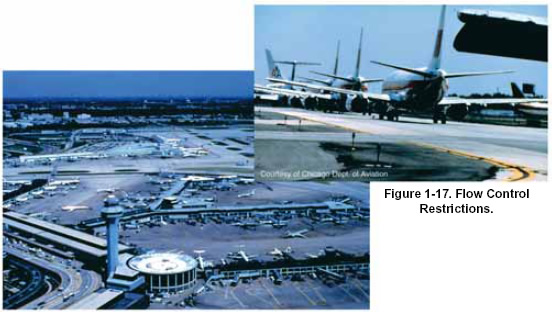 |
|
| INSTRUMENT PROCEDURES HANDBOOK |
|
FLOW CONTROL ATC provides IFR aircraft separation services for NAS users. Since the capabilities of IFR operators vary from airlines operating hundreds of complex jet aircraft to private pilots in single engine, piston-powered airplanes, the ATC system must accommodate the least sophisticated user. The lowest common denominator is the individual controller speaking to a single pilot on a VHF voice radio channel. While this commonality is desirable, it has led to a mindset where other opportunities to interact with NAS users have gone undeveloped. The greatest numbers of operations at the 20 busiest air carrier airports are commercial operators (airlines and commuters) operating IFR with some form of ground-based operational control. Since not all IFR operations have ground-based operational control, very little effort has been expended in developing ATC and Airline Operations Control Center (AOC) collaboration techniques, even though ground-based computer-to-computer links can provide great data transfer capacity. Until the relatively recent concept of Air Traffic Control-Traffic Flow Management (ATC-TFM), the primary purpose of ATC was aircraft separation, and the direct pilot-controller interaction was adequate to the task. Effective and efficient traffic flow management now requires a new level of control that includes the interaction of and information transfer among ATC, TFM, AOCs, and the cockpit. [Figure 1-17]
As the first step in modernizing the traffic flow management infrastructure, the FAA began reengineering traffic flow management software using commercial off-the-shelf products. In FY 1996, the FAA and NASA collaborated on new traffic flow management research and development efforts for the development of collaborative decision making tools that will enable FAA traffic flow managers to work cooperatively with airline personnel in responding to congested conditions. Additionally, the FAA provided a flight scheduling software system to nine airlines. LAND AND HOLD SHORT OPERATIONS Many older airports, including some of the most congested, have intersecting runways. Expanding the use of Land and Hold Short Operations (LAHSO) on intersecting runways is one of the ways to increase the number of arrivals and departures. Currently, LAHSO operations are permitted only on dry runways under acceptable weather conditions and limited to airports where a clearance depends on what is happening on the other runway, or where approved rejected landing procedures are in place. A dependent procedure example is when a landing airplane is a minimum distance from the threshold and an airplane is departing an intersecting runway, the LAHSO clearance can be issued because even in the event of a rejected landing, separation is assured. It is always the pilotís option to reject a LAHSO clearance. Working with ICAO, pilot organizations, and industry groups, the FAA is developing new LAHSO procedures that will provide increased efficiency while maintaining safety. These procedures will address issues such as wet runway conditions, mixed commercial and general aviation operations, the frequency of missed approaches, and multi-stop runway locations. After evaluating the new procedures using independent case studies, the revised independent LAHSO procedures may be implemented in the near future. SURFACE MOVEMENT GUIDANCE AND CONTROL SYSTEM To enhance taxiing capabilities in low visibility conditions and reduce the potential for runway incursions, improvements have been made in signage, lighting, and markings. In addition to these improvements, airports have implemented the Surface Movement Guidance and Control System (SMGCS),4 a strategy that requires a low visibility taxi plan for any airport with takeoff or landing operations with less than 1,200 feet RVR visibility conditions. This plan affects both aircrew and airport vehicle operators, as it specifically designates taxi routes to and from the SMGCS runways and displays them on a SMGCS Low Visibility Taxi Route chart. SMGCS is an increasingly important element in a seamless, overall gate-to-gate management concept to ensure safe, efficient air traffic operations. It is the ground-complement for arrival and departure management and the en route components of free flight. The FAA has supported several major research and development efforts on SMGCS to develop solutions and prototype systems that support pilots and ATC in their control of aircraft ground operations. |
